Baker’s used to use old dough. Nowadays it’s Pâte fermentée
Using Pâte fermentée in your bread of the secrets to making great tasting loaves and is part of my series Bake Better Bread.
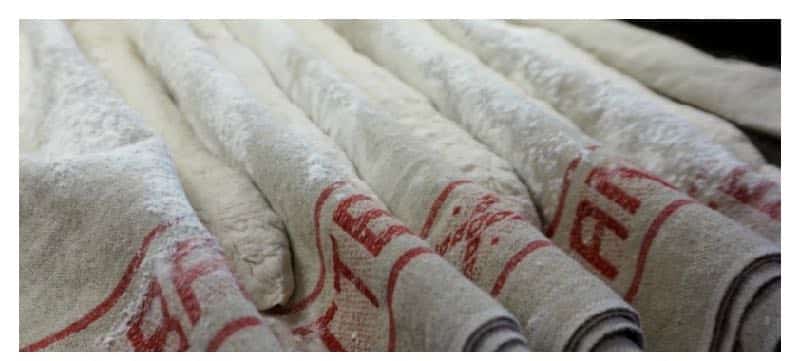
Pâte fermentée or Pre-fermented dough
Its French name is pâte fermentée (fermented dough) or PF for short. Traditionally, bakers kept some of the dough made on one day back to start the next day’s dough.It is also sometimes referred to as “old dough” which is somewhat less appealing!
Adding the pre-fermented dough (PF) to your bread recipe really develops and improves the flavour. You need to add less yeast (you must still add some) and you need to knead less. It’s an absolute must if you are making French baguettes
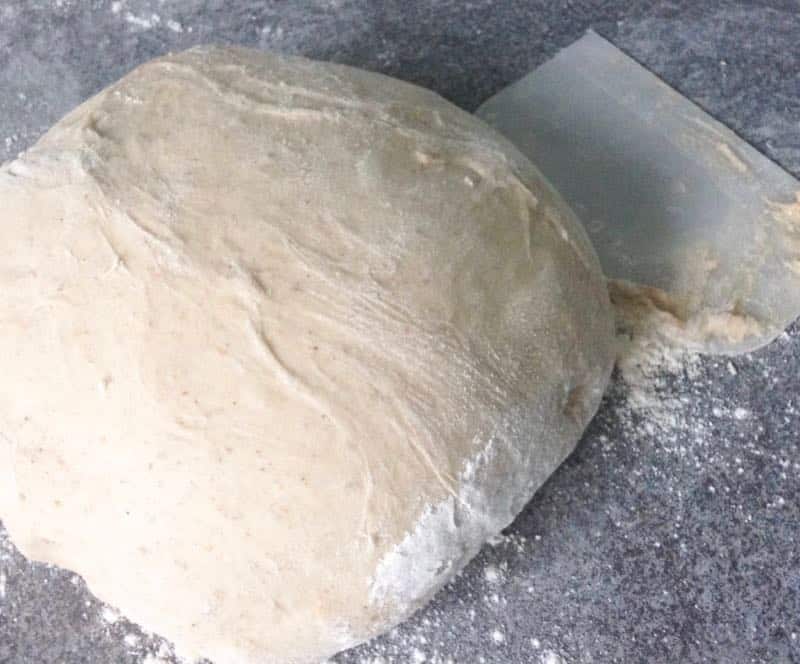
It’s widely used in France especially when making “traditional” baguettes. There’s actually a law dating back to 1993 that decrees that only traditional flour (without additives), yeast and salt must be used and that the dough should not be frozen at any point. This is where the pâte fermentée helps kick start the bread making process. Always ask for “une Baguette de Tradition “when buying a loaf in France. Other types of baguette may have additives.
How to make pâte fermentée / pre-fermented dough.
You’ll be pleased to know that you do not have to keep back dough, you can make pre-fermented dough from scratch. Once made put it in the fridge and it is ready to use after 3 hours. Store in the fridge for 3-4 days and take out the amount you need for your recipe. The PF is added to bread recipes, but can also be added to sweet doughs and croissants although purists will insist on PF made of sweet dough.
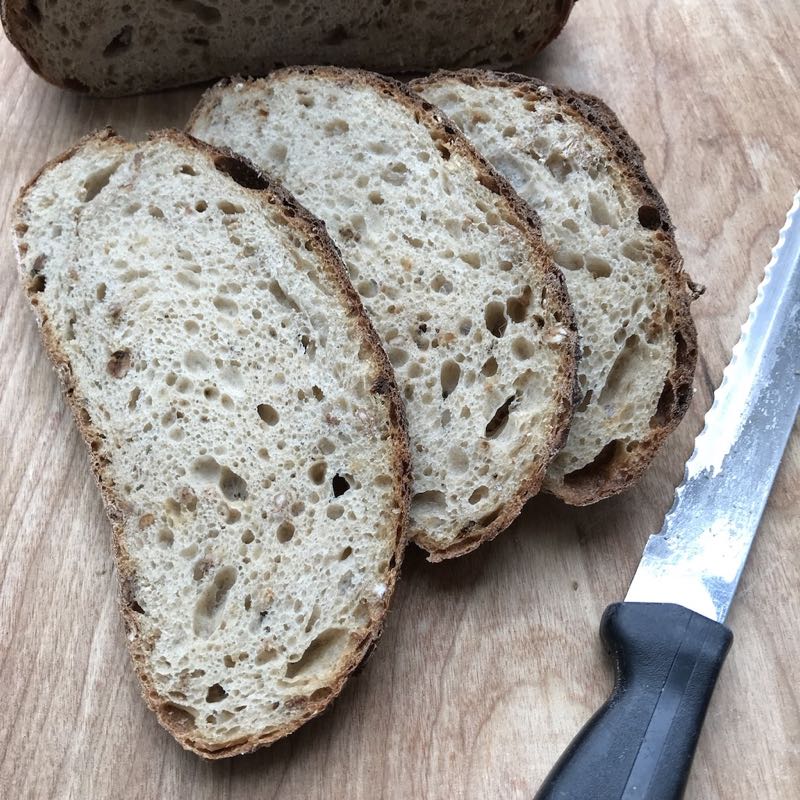
It will rise a little in a cool fridge, but sits there quite happily until you need it. It can be made with whatever gluten rich flour you have to hand – white, brown or wholewheat. I tend to make white pâte fermentée which goes with everything. The yeast content is typically 1% and salt content in PF is usually 1 to 1.5% of the flour weight.
Other pre-ferments for bread
Other pre-ferments include: biga which is a firm mixture with no salt added (this ferment can be made with either baker’s yeast or levain); poolish which is liquid and contains less yeast than biga; and a sponge which is usually used for a short term ferment used to help heavier flours get going. Of course, sourdough could be called a pre-ferment too.
How to use pâte fermentée
The pâte fermentée can be used in any existing recipe, simply add in at the same time as the other ingredients typically 20% of the flour weight. The amount of yeast required in most bread recipes can be reduced to 1% of flour weight if using the pre-fermented dough. You do not need to adjust the hydration (amount of water added) of the dough. Why not book a breadmaking session with me?
Recipe for Pâte fermentée
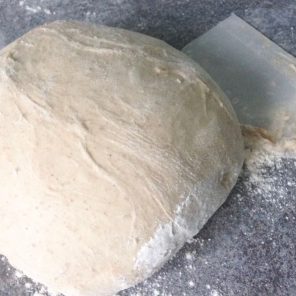
Pate Fermentee - Pre-fermented dough
Ingredients
- 500 grams white bread flour (100%) eg Shipton Mill Organic No. 4, Type 55 or Type 65 French flour
- 5 grams fresh yeast (1%) or dried yeast available from most supermarket bread counters or half sachet of dried ueast
- 5 grams salt (1%)
- 300 millilitres water (60%)
Instructions
- If you are making it in a stand mixer, place all ingredients in the bowl.
- Mix for 3 minutes at a low speed, then a further 3 minutes at medium speed. The dough should come away cleanly from the sides of the bowl. Check the temperature and ensure it reaches between 24 and 26°C (78°F)
- If you are making by hand, place the flour in a large bowl. Rub the fresh yeast into the flour. Add the salt, then the water. Mix well, then knead until smooth - about 10 minutes. Check the temperature and ensure it reaches between 24 and 26C (78F)
- Place the dough in a bowl or box and cover well. Place in the fridge and leave for at least 3 hours. Use within 3-4 days. Keep in the fridge at all times.
- To use, measure 20% of the weight of flour in your recipe of Pate Fermentee (eg 200 gr for 1 kilo of flour) and add it to the other ingredients at the same time as the flour.
Basic bread recipe using pâte fermentée
This is an ideal recipe to try. You can adapt it easily once you’ve made it the first time.

Basic Bread Recipe using pâte fermentée
Ingredients
- 500 grams white bread flour 100%
- 100 grams pâte fermentée (PF) 20%
- 350 millilitres water 70%
- 5 grams fresh yeast 1%
- 9 grams salt 1.8%
Instructions
- Stand mixer versionIf you are using a stand mixer, place the dry ingredients into the bowl ensuring the fresh yeast and salt are kept separately
- Add the pâte fermentée and water (Read more about water temperature). Mix on a low speed for 5 minutes
- Increase the speed to medium and mix for a further 3 minutes or until the dough comes away from the sides of the bowl. You can test whether the dough is ready by: checking the temperature which should be between 24° and 26°C or pull some of the dough to check the dough has some resistance does not break easily (window pan technique).
- Hand mix versionIf you are making the dough by hand, add the dry ingredients to the bowl. Rub the yeast into the flour lightly keeping it away from the salt. Add the pâte fermentée in small lumps. Add the water and mix well
- When all the flour is absorbed, take the dough out of the bowl and knead until smooth. Check the temperature, it should be about 24 degrees. Check the dough for resistance and that it will not break easily.
- ProvingFor either version, cover the bowl and leave at room temperature. It should be ready to shape after about an hour. Pre-heat your oven to 230°C. Read more about heat, steam and slashing your bread.
- ShapingShape your bread and leave for a further 45 minutes to an hour before baking. You can place it on a couche dusted with flour and cover, or in a banetton dredged with flour and covered.
- Pre heat your oven to 230°C /440°F an hour before you want to bake. If you have a pizza stone or equivalent pre-heat it too.
- BakingSlash the top of the loaf and place in the oven and bake for 35 minutes,
Learn to Bake Bread
Learn plenty of French breadmaking techniques in one of my breadmaking courses, there’s plenty to choose from.
Bake Better Bread: Baker’s Percentages
Bake Better Bread: Using heat and steam
Baker Better Bread: Baking in the Rofco

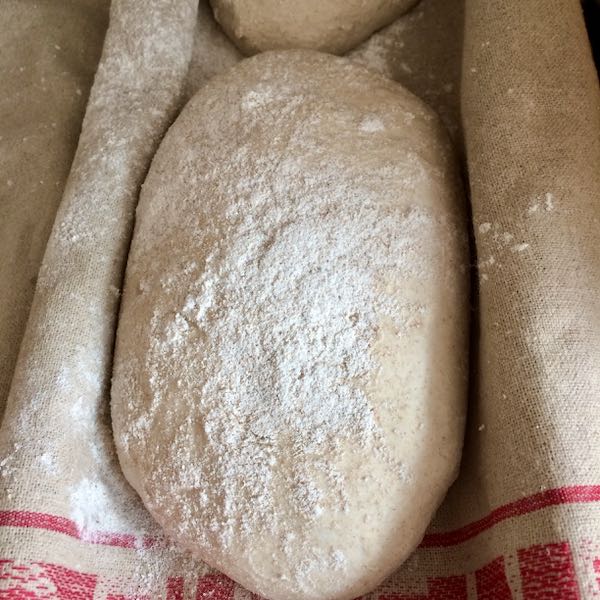
Sorry to hear you’ve had a problem. If you’re mixing by hand, you need to add the pate fermentee in small lumps. Once you’ve done a rough mix, leave it half an hour before kneading and you’ll find it will work.
Hi, just tried this recipe [mix by hand] the pate fermee seems fine, but when added to the other ingredients for the Dough it`s impossible to knead because it`s a runny gloop.
Thank you! This is brilliant. It has made such a difference to my bread. Great texture.
I tend to make half of this which gives me enough for three loaves.
My suggestion would be to put it in the fridge overnight before shaping. I’d then shape an hour before baking. If the timings do not work for you, yes do shape then leave overnight in the fridge. I would still leave it an hour before baking.
I am trying your recipe, my question after shaping can i leave the dough till tomorrow morning ? Start shaping at 9 pm ,
Is it ok if i bake the bread tommorow morning at 6 am ?
Thank you ?
Hi Danielle,
Your recipe looks great and simple! My granny used old dough for her baking.
If I wanted to go yeast free, could I remove the yeast from the dough mix, just using the rising power of the old dough? How long will you give for proving? Thanks!
Hi Emma, You certainly can make a smaller amount, just keep to the same percentages (I’ve updated the recipe to show that). The only thing you might find that it’s harder to mix in a small quantity. Think about how much flour you’re going to add it to in the final recipe too. eg 500 grams of flour, you’ll need 100 grams of PF
Hi this seems like a lot of pate fermente if it only keeps for 3 – 4 days. I just want to experiment as a first time, can I do a 5th of the recipe, 20%, will it work ok? Thanks
Hi Melissa. It’s definitely not a stupid question. If you place the salt directly on top of the yeast it will react with it and the yeast won’t work well. If you place the yeast and salt in separate locations in the bowl, this won’t be a problem. When you mix everything together, there’s enough flour and water to avoid any problems.
Let me know how you get on!
Help please! In the basic bread recipe using pate fermentee, what does it mean to ” place the dry ingredients into the bowl ensuring the fresh yeast and salt are kept separately”? How do you place the dry ingredients in the bowl and keep the yeast and salt separately? Aren’t they all about to be mixed up? My apologies if this is a stupid question…
This Bread looks so good and so soft. I have never tried bread at home, I always purchase it. But, I think I should try this bread at home by following your recipe. Thank you so much for sharing this great post. Please do keep sharing.